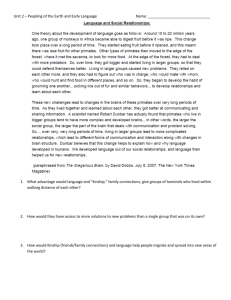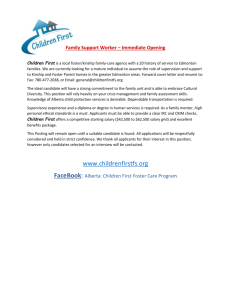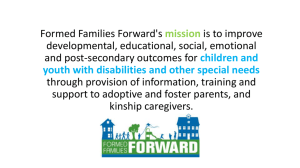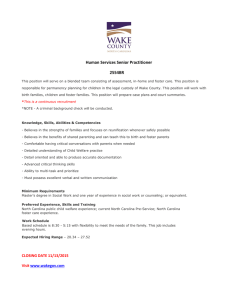Family Care or Foster Care? How State Policies Affect Kinship Caregivers A
advertisement
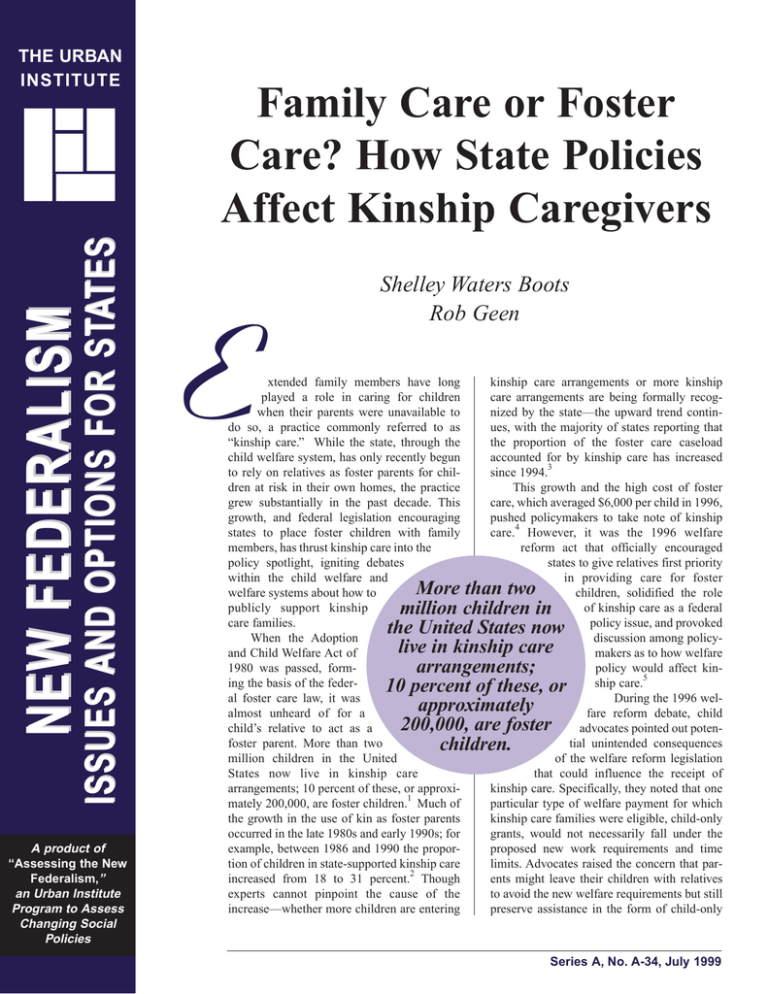
ISSUES AND OPTIONS FOR STATES NEW FEDERALISM THE URBAN INSTITUTE A product of “Assessing the New Federalism,” an Urban Institute Program to Assess Changing Social Policies Family Care or Foster Care? How State Policies Affect Kinship Caregivers Shelley Waters Boots Rob Geen E xtended family members have long played a role in caring for children when their parents were unavailable to do so, a practice commonly referred to as “kinship care.” While the state, through the child welfare system, has only recently begun to rely on relatives as foster parents for children at risk in their own homes, the practice grew substantially in the past decade. This growth, and federal legislation encouraging states to place foster children with family members, has thrust kinship care into the policy spotlight, igniting debates within the child welfare and welfare systems about how to publicly support kinship care families. When the Adoption and Child Welfare Act of 1980 was passed, forming the basis of the federal foster care law, it was almost unheard of for a child’s relative to act as a foster parent. More than two million children in the United States now live in kinship care arrangements; 10 percent of these, or approxi1 mately 200,000, are foster children. Much of the growth in the use of kin as foster parents occurred in the late 1980s and early 1990s; for example, between 1986 and 1990 the proportion of children in state-supported kinship care 2 increased from 18 to 31 percent. Though experts cannot pinpoint the cause of the increase—whether more children are entering kinship care arrangements or more kinship care arrangements are being formally recognized by the state—the upward trend continues, with the majority of states reporting that the proportion of the foster care caseload accounted for by kinship care has increased 3 since 1994. This growth and the high cost of foster care, which averaged $6,000 per child in 1996, pushed policymakers to take note of kinship 4 care. However, it was the 1996 welfare reform act that officially encouraged states to give relatives first priority in providing care for foster children, solidified the role of kinship care as a federal policy issue, and provoked discussion among policymakers as to how welfare policy would affect kin5 ship care. During the 1996 welfare reform debate, child advocates pointed out potential unintended consequences of the welfare reform legislation that could influence the receipt of kinship care. Specifically, they noted that one particular type of welfare payment for which kinship care families were eligible, child-only grants, would not necessarily fall under the proposed new work requirements and time limits. Advocates raised the concern that parents might leave their children with relatives to avoid the new welfare requirements but still preserve assistance in the form of child-only More than two million children in the United States now live in kinship care arrangements; 10 percent of these, or approximately 200,000, are foster children. Series A, No. A-34, July 1999 No. A-34 NEW FEDERALISM: ISSUES AND OPTIONS FOR STATES Less Stringent Few or no requirements; often called unlicensed Licensing Caregivers More Stringent Separate approval process for kin Waive some of full standard’s requirements Full standards for licensing— same as non-kin Child Welfare Agency 6 grants. They also worried that kinship care providers, who used to care for children informally, would seek assistance from the child welfare system if forced to meet welfare require7 ments. In 1997, the Urban Institute surveyed state foster care administrators to gather information on state policies for identifying, licensing, and financially supporting kinship care families. Previous to this study, little information existed on state kinship care policies. Defining the Term “Kinship Care” Because kinship care has many forms, it is helpful to think of it as a continuum of interventions and support. At one end are private kinship care families, with no contact at all with the child welfare system. In the middle are kinship care families known to the system but not formally a part of it, some of whom may be receiving support services. At the other end are families caring for children in state custody and receiving ongoing attention from the child welfare system. For the purposes of this brief, a “public” kinship care child refers to a child whose placement was arranged by child welfare authorities, 2 members to care for children in the fos8 ter care system. Figure 1 Public Kinship Care: Requirements to Become a Foster Parent whether or not the child was taken into custody by those authorities. Policies Affecting Public Kinship Care Families Our survey reveals the variations state child welfare agencies have developed in their policies for public kinship care. States can differ in three primary ways: (1) who they consider eligible caregivers, (2) how they license or approve family members for caregiving, and (3) how they support kinship families within the child welfare system. Eligible Caregivers The types of relatives who can provide care for foster children vary by state. Of the 50 states whose administrators responded to the Urban Institute kinship care survey on this question, 26 stated that their policies mandate that family members must be related to a child by blood or through marriage to a blood relative. Twenty include a variety of additional categories such as neighbors, godparents, and other adults who have a close relationship with the child, and the other four have no formal definition. Regardless of how states define kin, almost all give preference to relatives over non-kin foster parents, and many actively work to recruit family In order to care for a child in state custody, foster caregivers must first be licensed, or approved, by the state child welfare agency. The standards upon which kinship caregivers are assessed for licensure vary (figure 1). In states with the most stringent requirements, kinship families are subject to the same standards that govern non-kin foster families—they must be “fully licensed.” Almost all states (44 out of 50 responding) reported that these families receive visits by caseworkers who provide supervision and intervention, just like non-kin foster parents. Fully licensed families are often eligible for all the benefits and supports available to a non-kin foster parent, including foster care maintenance payments, respite child care, and other support services. Other states maintain less stringent requirements. For example, some kinship families meet all except a few of the licensing standards. States often waive specific licensure requirements (such as physical space or training) for kinship families, as long as they do not jeopardize the safety of the child. Other states license kinship families under a set of criteria established especially for them. Usually these standards are less stringent, focusing more on child safety and family support than on regulations that are difficult for some kin to meet and could prohibit a family from staying together. Some states allow relatives to care for children with minimal standards and minimal supervision—sometimes called unlicensed kinship care. To clarify the different ways in which they evaluate kinship families, we asked states to specify the available options for licensing relative caregivers within their state. Most states (including the District of Columbia) offer more licensing options to kin than to non-kin foster parents. In 41 of the 51 states, for example, relatives have at least one licensing option besides the licensing standard applied to nonrelative foster care providers. In the remaining 10 states, family members can only care No. A-34 Figure 2 Licensing Standards and Payments for Kinship Foster Parents WA MT VT ND OR MN ID WI SD MI WY IA NE NV UT CA AZ PA IL CO NY KS OK NM MO KY WV VA NC TN AR NH MA RI CT NJ DE DC MD SC MS TX OH IN ME AL GA LA FL AK HI Supporting Caregivers Payment of kinship foster caregivers varies according to the licensing a caregiver receives (table 1). When relatives have the same licensing as non-kin caregivers, the vast majority of states allow them a 9 full foster care payment. As seen in figure 2, of the 41 states that offer a less stringent standard, 22 still provide a foster care payment to kinship caregivers. In the 19 states that do not provide foster care payments to these families, usually the only compensation available is some type of cash welfare grant, which in almost all states is less generous than a foster care payment. Some states require kinship caregivers to meet additional criteria. For example, in California, no matter what licensing standard a family meets, if the children in the relative home are not from a poor family (as defined by the welfare eligibility of the home they left), the relative family cannot get a foster care payment, regardless of the relative family’s own income. Missouri has even more complicated criteria for foster care payment eligibility. It specifies that all grandparent caregivers can receive a foster care payment, but any other type of relative can receive foster care payments only if they are caring for children who come from a poor family (also defined as welfare eligible). Less stringent licensing option for kinship care. Receive foster care payment. Less stringent licensing option for kinship care. Payment is generally lower than foster care rate. In both these states, all other kinship care families must rely on welfare for financial assistance. Future Policy Challenges Many factors determine how a kinship care family is treated. Policies vary from state to state, and even within a state different families may receive a wide range of care. The survey of state child welfare administrators underscores that kinship families in most states (41) are held to a less stringent standard for foster family eligibility than nonrelative foster families. However, about half these states do not provide foster care payments to the kinship families meeting a lower standard, leaving them to apply for welfare or other government assistance, which is typically less generous. Because foster care payments are usually higher than welfare grants, these payment differences result in stark differences in the resources provided to public kinship care families within and across states. For example, Kin must meet all foster care requirements to care for a child in the foster care system. Receive foster care payment. in Maryland, a child being cared for by a relative licensed as a foster caregiver would have received $535 to $550 a month for care in 1996. A similar child in the same state being cared for by a welfare-assisted relative would have received only $165 a month for a basic child-only grant. These differences become even greater when there are multiple siblings in care; the welfare payment is prorated on a declining scale when there are multiple children, whereas foster care payments per child remain constant regardless of the number of children in the household. Two children living in Maryland with relatives licensed by the foster care system would have received $1,070 to $1,100 a month, but two children financed by that state’s Aid to Families with Dependent Children (AFDC) program in 1996 would have received 10 $292 a month. Further, a public kinship care family might be paid a foster care payment in one state while the same family licensed by the same standards NEW FEDERALISM: ISSUES AND OPTIONS FOR STATES for children in state custody if they comply with all state policies for foster caregivers. Many of the 41 states with more flexible requirements for kinship foster care have more than one licensing option for kinship homes. For instance, Maryland has two other options available for relatives besides a fully licensed standard: They can either get licensed by the foster care agency under less stringent criteria (and receive a foster care payment), or they can be considered an unlicensed home, meet even less stringent requirements (usually only safety requirements), and apply for welfare benefits. The licensing option a kinship caregiver chooses can be a function of family preferences as well as state policy. 3 No. A-34 Table 1 1996 State Kinship Care Payments Kinship caregivers subject to less stringent licensing standard receive foster care payment. NEW FEDERALISM: ISSUES AND OPTIONS FOR STATES State Alabama Alaska Arizona Arkansas California Colorado Connecticut Delaware Dist. of Columbia Florida Georgia Hawaii Idaho Illinois Indiana Iowa Kansas Kentucky Louisiana Maine Maryland Massachusetts Michigan Minnesota Mississippi Missouri Montana Nebraska Nevada New Hampshire New Jersey New Mexico New York North Carolina North Dakota Ohio Oklahoma Oregon Pennsylvania Rhode Island South Carolina South Dakota Tennessee Texas Utah Vermont Virginia Washington West Virginia Wisconsin Wyoming Foster Care Payment ($)* Alternative Payment ($)** Kinship caregivers subject to less stringent licensing standard receive AFDC payment. Those who meet regular foster care requirements receive foster care payment. Foster Care Payment ($)* 577 422 433 410 422 433 a 293 597 597 467 262 529 279 330 348 441 260 257 375 394 324 339 439 b Alternative Payment ($)** 225 225 384 384 383 201 325 155 321 321 380 269 462 411 332 462 411 332 456 456 393 393 482 319 482 319 c 330 b 72 349 540 118 165 388 276 441 d b 60 b 136 952 394 324 e 353 329 414 f 162 365 371 544 360 349 181 110 g 303 112 209 339 439 b 327 377 328 173 328 400 Foster Care Payment ($)* 452 529 279 294*** 319 Alternative Payment ($)** Kinship caregivers who are “fully licensed,” or meet regular foster care requirements, receive foster care payment. b 252 118 445 357 373 400 318 349 149 215 319 400 Sources: Average foster care payment rate represents the average payment in 1996 across ages 2, 9, and 16 as cited in the American Public Welfare Association’s W-Memo, January–February 1998. AFDC rates are for one child, based on data from an annual benefit survey by the Congressional Research Service and from Urban Institute tabulations of AFDC state plan information. Notes: * Per child per month. ** Maximum 1996 AFDC rate for one child, except where otherwise noted. Unlike foster care payments, AFDC payments are prorated based on the number of children. *** Amount for 1995; 1996 unavailable. a. Kinship caregivers can receive foster care payment if children come from a poor home. All others are unlicensed and can receive AFDC. b. In addition, kinship caregivers can choose to be unlicensed and receive AFDC. c. Less stringent licensing pays AFDC standard-of-need rate. d. Those who meet regular foster care requirements receive foster care payment if children come from a poor home. Counties have the option to pay regular foster care payment to kinship caregivers for children not from poor homes. continued 4 in the care of a relative, and recommend any necessary federal policy changes. In addition to altering foster care regulations, Congress is also considering block granting all federal child welfare funds, giving states more discretion in spending these funds. In this rapidly changing policy environment, states will likely continue to face a complex array of options and incentives for financing both public and private kinship care. statute and regulations, it appears possible that states could protect themselves from the requirement and associated penalty risk by converting regular welfare cases into child-only cases.” Notes 8. In placing children in foster care, 49 states report that they give preference to kin over non-kin foster parents and 31 states report doing so for more than five years. Results from 1997 Urban Institute survey. 2. Kusserov, Richard. 1992. Using Relatives for Foster Care. Office of Inspector General. Based on results from 25 states that reported data. 3. Urban Institute survey, 1997. 4. Geen, Rob, Shelley Waters Boots, and Karen C. Tumlin. 1999. The Cost of Protecting Vulnerable Children: Understanding the Complexities of Federal, State, and Local Child Welfare Spending. Washington, D.C.: Urban Institute Press. 5. Under the Personal Responsibility and Work Opportunity Reconciliation Act of 1996, states shall “consider giving preference to an adult relative over a nonrelated caregiver when determining a placement for a child, provided that the relative caregiver meets all relevant state child protection standards.” 6. In the Notice of Proposed Rulemaking for implementation of the Temporary Assistance for Needy Families (TANF) program, the U.S. Department of Health and Human Services notes that it was “concerned that states might be able to avoid the work participation rates and time limits by excluding adults (particularly parents) from the eligible cases. Given the flexibility available to states under the 7. Under the enacted federal welfare reform legislation, states have the flexibility to decide whether to continue to provide child-only grants to kinship care families and whether to require kinship providers to meet work requirements and be subject to time limits. 9. Only a few states (California, Oregon, New Jersey) make an exception to this rule—prohibiting families who do not care for children coming from a poor home from receiving the full foster care payment. Instead, these families usually receive assistance in applying for AFDC. In Michigan, counties decide whether or not to allow kin caring for noneligible children to be fully licensed. 10. Data from an annual benefit survey by the Congressional Research Service and from Urban Institute tabulations of AFDC state plan information. 11. For example, under a 1996/1997 component of their welfare waiver, Wisconsin developed a kinship care payment system separate from its foster care system, which provides an ongoing subsidy to kinship families. Wisconsin’s Kinship Care Program is funded through the state income maintenance program and allows the state to support public and private kinship caregivers. Under the program, families are still subject to a review every 12 months to ensure that safety issues are properly addressed. In Florida, TANF dollars are being used to fund the Relative Care Giver Program, which allows kin caring for children who may otherwise go into the foster care system to receive payments of up to 80 percent of the foster care rate. NEW FEDERALISM: ISSUES AND OPTIONS FOR STATES 1. U.S. Census Bureau, March 1998, and Urban Institute analysis of data from the 1998 National Survey of America’s Families. No. A-34 might only be eligible for welfare in another state. In New Jersey (like California), for example, relatives caring for children who did not come from a poor home cannot receive foster care payments; they can only obtain welfare (averaging $162 for one child in 1996), regardless of what licensing standards they are qualified to meet. In New York, the same family can apply for licensing and, if they meet the standards, receive a foster care payment (averaging $439 to $474 per child in 1996) for the children in their care. Since the federal government began providing states with foster care funds, it has carefully regulated states’ foster care practices, detailing what states must do to receive federal reimbursement for certain state expenditures. The federal government has not developed specific regulations on whether or how states can treat kinship care families who are eligible for foster care differently from those who are not. As this brief has illustrated, many states have used the flexibility within existing federal foster care regulations to design different kinship care licensing standards. Federal and state kinship care policies are in flux. Since our survey, additional states have created or are considering creating alternative kinship care licensing standards and payment options. Some states have created new kinship care financing schemes through their Temporary Assistance for Needy 11 Families programs. At the same time, many states are urging the federal government to reform federal regulations to allow states greater flexibility in serving kinship care arrangements while maintaining eligibility for foster care reimbursement. In 1997, as part of the Adoption and Safe Families Act, Congress instructed the U.S. Department of Health and Human Services to convene an advisory panel on kinship care, produce a report that documents the extent to which children in foster care are placed Notes from table 1, continued e. Respondents from New Hampshire said that although the full AFDC amount can be up to $414 per child, most kin are not eligible for the shelter costs portion of the AFDC grant. Instead, families receive a benefit level of $171 per child for a child-only grant. Therefore, for many families in New Hampshire, there might have been a financial incentive to receive foster care rather than AFDC. f. Those who meet regular foster care requirements receive foster care payment if children come from a poor home. g. Less stringent licensing pays AFDC plus $100 for a maximum of six months. 5 NEW FEDERALISM: ISSUES AND OPTIONS FOR STATES THE URBAN INSTITUTE 2100 M Street, N.W. Washington, D.C. 20037 Nonprofit Org. U.S. Postage PAID Permit No. 8098 Washington, D.C. Address Service Requested Telephone: (202) 833-7200 ■ Fax: (202) 429-0687 ■ E-Mail: paffairs@ui.urban.org ■ Web Site: http://www.urban.org About the Authors No. A-34 Shelley Waters Boots was a research associate in the Urban Institute’s Population Studies Center. Her research focused on child welfare, child care, child support, and welfare reform. For the Assessing the New Federalism project, she led a team that collected and analyzed the kinship care data used in this policy brief. Ms. Boots is currently the director of research for the California Child Care Resource and Referral Network. Rob Geen is a research associate in the Urban Institute’s Population Studies Center, specializing in child welfare and related child, youth, and family issues. He directed the Child Welfare Survey and is also leading other child welfare–related research conducted as part of the Assessing the New Federalism project. This series is a product of Assessing the New Federalism, a multiyear project to monitor and assess the devolution of social programs from the federal to the state and local levels. Alan Weil is the project director. The project analyzes changes in income support, social services, and health programs. In collaboration with Child Trends, the project studies child and family well-being. The project has received funding from The Annie E. Casey Foundation, the W.K. Kellogg Foundation, The Robert Wood Johnson Foundation, The Henry J. Kaiser Family Foundation, The Ford Foundation, The John D. and Catherine T. MacArthur Foundation, the Charles Stewart Mott Foundation, The David and Lucile Packard Foundation, The McKnight Foundation, The Commonwealth Fund, the Stuart Foundation, the Weingart Foundation, The Fund for New Jersey, The Lynde and Harry Bradley Foundation, the Joyce Foundation, and The Rockefeller Foundation. This series is dedicated to the memory of Steven D. Gold, who was codirector of Assessing the New Federalism until his death in August 1996. Publisher: The Urban Institute, 2100 M Street, N.W., Washington, D.C. 20037 Copyright © 1999 The views expressed are those of the authors and do not necessarily reflect those of the Urban Institute, its board, its sponsors, or other authors in the series. Permission is granted for reproduction of this document, with attribution to the Urban Institute. For extra copies call 202-261-5687, or visit the Urban Institute’s Web site (http://www.urban.org) and click on “Assessing the New Federalism.”
